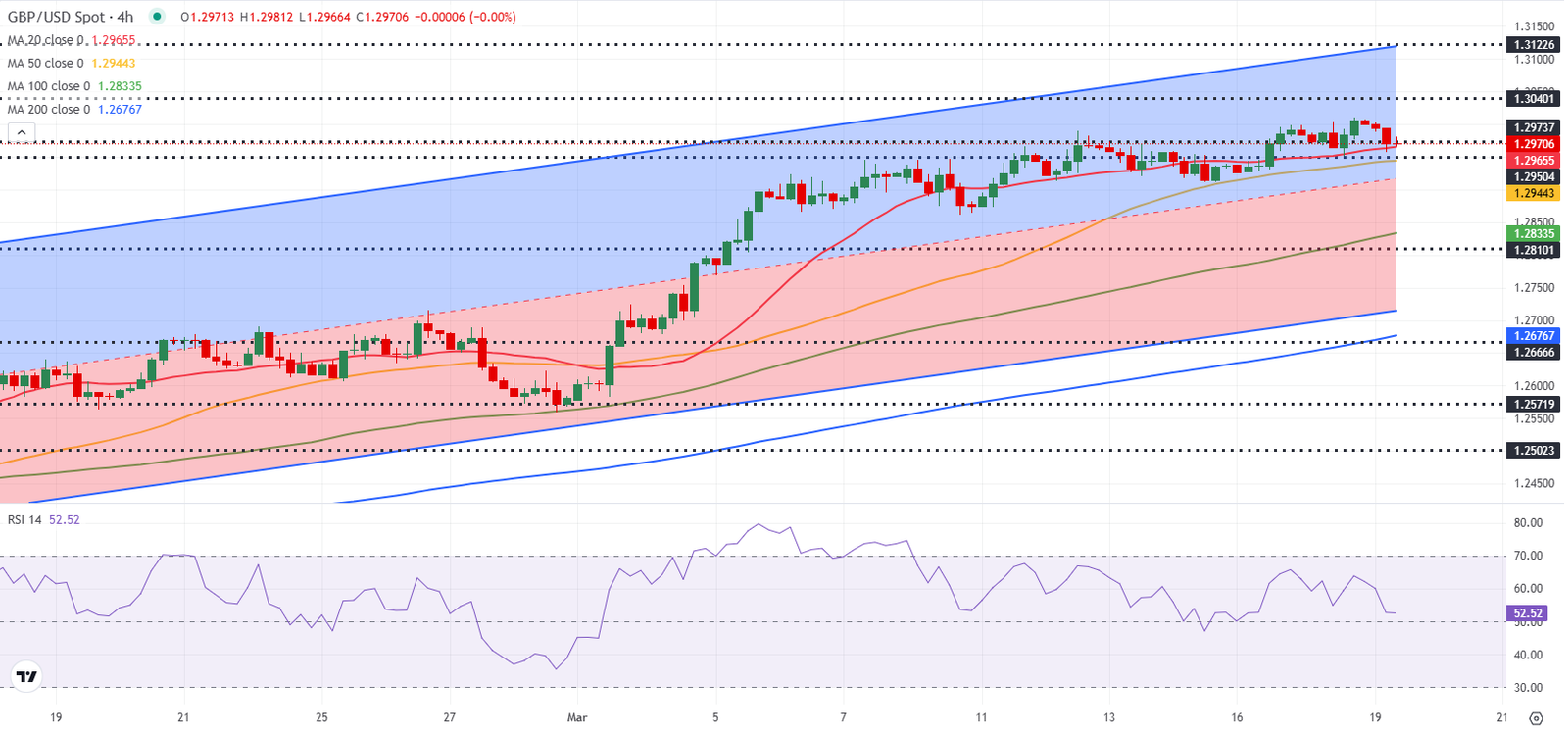- GBP/USD trades in negative territory below 1.3000 on Wednesday.
- The US Dollar benefits from the cautious market mood.
- The Federal Reserve is forecast to maintain monetary policy settings after the March meeting.
After posting strong gains on Monday, GBP/USD continued to edge higher on Tuesday and touched its strongest level since early November above 1.3000. The pair stays on the back foot and trades below 1.3000 in the European session on Wednesday.
British Pound PRICE Today
The table below shows the percentage change of British Pound (GBP) against listed major currencies today. British Pound was the weakest against the US Dollar.
| USD | EUR | GBP | JPY | CAD | AUD | NZD | CHF | |
|---|---|---|---|---|---|---|---|---|
| USD | 0.38% | 0.24% | 0.19% | 0.11% | 0.46% | 0.53% | 0.07% | |
| EUR | -0.38% | -0.15% | -0.16% | -0.27% | 0.09% | 0.15% | -0.31% | |
| GBP | -0.24% | 0.15% | -0.04% | -0.12% | 0.24% | 0.29% | -0.19% | |
| JPY | -0.19% | 0.16% | 0.04% | -0.11% | 0.26% | 0.30% | -0.15% | |
| CAD | -0.11% | 0.27% | 0.12% | 0.11% | 0.37% | 0.44% | -0.08% | |
| AUD | -0.46% | -0.09% | -0.24% | -0.26% | -0.37% | 0.05% | -0.36% | |
| NZD | -0.53% | -0.15% | -0.29% | -0.30% | -0.44% | -0.05% | -0.48% | |
| CHF | -0.07% | 0.31% | 0.19% | 0.15% | 0.08% | 0.36% | 0.48% |
The heat map shows percentage changes of major currencies against each other. The base currency is picked from the left column, while the quote currency is picked from the top row. For example, if you pick the British Pound from the left column and move along the horizontal line to the US Dollar, the percentage change displayed in the box will represent GBP (base)/USD (quote).
The cautious market stance helps the US Dollar (USD) stay resilient against its rivals midweek and causes GBP/USD to stretch lower.
In the late American session, the Federal Reserve (Fed) will announce monetary policy decisions and publish the revised Summary of Economic Projections (SEP), the so-called dot plot.
The Fed is widely anticipated to leave the interest rate unchanged at 4.25%-4.5%. Hence, market participants are likely to react to changes in the dot plot. In December, the dot plot showed that policymakers were projecting a total of 50 basis point (bps) reduction in the policy rate in 2025, while forecasting an annual Gross Domestic Product (GDP) growth of 2.1% and seeing an annual Personal Consumption Expenditure (PCE) inflation of 2.5% at year-end.
In case the revised SEP shows no change in the interest rate projections but highlights a downward revision to growth expectations, the immediate reaction could trigger a US Dollar (USD) selloff. On the other hand, the USD could gather strength if policymakers project only one rate cut in 2025.
Following the release of the policy statement and the revised SEP, Chairman Jerome Powell will comment on the policy outlook in a press conference and respond to questions from the press. In case he adopts a cautious tone on the economic outlook, citing the potential negative impact of US President Donald Trump’s policy changes on the activity, the USD could struggle to find demand. On the other hand, the USD could preserve its strength and weigh on GBP/USD if Powell downplays growth concerns and reiterates the cautious approach to policy due to the uncertainty surrounding the inflation outlook.
GBP/USD Technical Analysis
The Relative Strength Index (RSI) indicator on the 4-hour chart declines toward 50 and GBP/USD retreats toward the mid-point of the ascending regression channel, pointing to a loss of bullish momentum.
GBP/USD could face interim support at 1.2950 (50-period Simple Moving Average (SMA)) ahead of 1.2910-1.2900 (mid-point of the ascending channel, round level) and 1.2870 (static level). On the upside, 1.3000 (static level, round level) aligns as immediate resistance before 1.3040 (static level) and 1.3120 (upper limit of the ascending channel).
Pound Sterling FAQs
The Pound Sterling (GBP) is the oldest currency in the world (886 AD) and the official currency of the United Kingdom. It is the fourth most traded unit for foreign exchange (FX) in the world, accounting for 12% of all transactions, averaging $630 billion a day, according to 2022 data. Its key trading pairs are GBP/USD, also known as ‘Cable’, which accounts for 11% of FX, GBP/JPY, or the ‘Dragon’ as it is known by traders (3%), and EUR/GBP (2%). The Pound Sterling is issued by the Bank of England (BoE).
The single most important factor influencing the value of the Pound Sterling is monetary policy decided by the Bank of England. The BoE bases its decisions on whether it has achieved its primary goal of “price stability” – a steady inflation rate of around 2%. Its primary tool for achieving this is the adjustment of interest rates. When inflation is too high, the BoE will try to rein it in by raising interest rates, making it more expensive for people and businesses to access credit. This is generally positive for GBP, as higher interest rates make the UK a more attractive place for global investors to park their money. When inflation falls too low it is a sign economic growth is slowing. In this scenario, the BoE will consider lowering interest rates to cheapen credit so businesses will borrow more to invest in growth-generating projects.
Data releases gauge the health of the economy and can impact the value of the Pound Sterling. Indicators such as GDP, Manufacturing and Services PMIs, and employment can all influence the direction of the GBP. A strong economy is good for Sterling. Not only does it attract more foreign investment but it may encourage the BoE to put up interest rates, which will directly strengthen GBP. Otherwise, if economic data is weak, the Pound Sterling is likely to fall.
Another significant data release for the Pound Sterling is the Trade Balance. This indicator measures the difference between what a country earns from its exports and what it spends on imports over a given period. If a country produces highly sought-after exports, its currency will benefit purely from the extra demand created from foreign buyers seeking to purchase these goods. Therefore, a positive net Trade Balance strengthens a currency and vice versa for a negative balance.





















